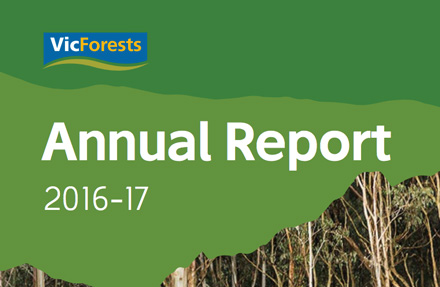
VicForests has achieved a positive profit from operations before tax of $1.5 million in 2016/17, highlighting the continued demand for native timber in Victoria. Source: Timberbiz
According to VicForest it is a good result considering the operational challenges faced.
The company’s result after tax was a loss of $3.2 million, due to a decrease in the accounting valuation of the area of State forest available to be harvested for timber.
VicForests Chief Executive Officer, Nathan Trushell, said he was pleased with the profit from operations, and that the loss after tax is the outcome of more forest being placed in reserves and not a reduction in demand for timber.
“Due to an increase in conservation efforts, areas previously available to us have been excluded from timber harvesting over the past year,” Mr Trushell said.
“So while the value of the timber remains the same, there is less forest available to harvest and therefore the asset value is reduced.
“This is not a reflection of the excellent work our staff have done this year, which has generated a profit from our operations.
“VicForests has continued to strengthen our cash position and as a result of sales during the 2016/17 financial year we currently have no debt,” he said.
Mr Trushell said that despite the decrease in area available to be harvested, the demand for timber remains strong.
“Demand for timber remains high in Victoria and Australia. The most recent report by Australian Forest and Wood Products Statistics indicates that Australia is importing more than $5 billion in wood products annually to meet the demand we are unable to supply locally.
“The vast majority of Victoria’s native forests will never be harvested. Victoria has a truly world class forest parks and reserve system that covers an area the size of Tasmania.
“However, the forest is a dynamic environment, and so we must continue to evolve the way we implement conservation measures. Our staff passionately care about forests, that is why they have chosen to undertaken specialist degrees and spend their life working in the forest.
“We’re proud of the role our foresters play in helping to protect threatened species as part of managing a renewable resource for all Victorians,” he said.
Mr Trushell said that the native timber industry continued to make a significant contribution to the Victorian economy.
“Economic activity within the timber industry and demand for native hardwood remains high underscoring our contribution to the Victorian economy.
“The native timber industry contributes hundreds of millions of dollars and thousands of jobs to regional Victoria regional each year. A study released by Deloitte Access Economics last year reported that the native timber industry in Victoria generated $573 million in economic activity during 2013/14 in the Central Highlands region alone.
“Beyond the impressive revenue number, native forestry supports the Victorian community by underpinning entire industries and many regional areas. The report found that native forestry in this region creates full-time employment for more than 2,100 people,” Mr Trushell said.
Given the continued demand and positive developments in the sector, Mr Trushell was optimistic about the coming year.
“Our staff are hard at work in revising our forest management practices to adapt to the currently available resources. We intend to focus on our long-term financial sustainability while continuing to contribute to the growing demand for timber products in Victoria,” he said.
VicForests results are audited each year by the Victorian Auditor General’s Office.
VicForests 2017 Annual report is available to view at www.vicforests.com.au/about-vicforests/corporate-reporting-1/corporate-reports.





